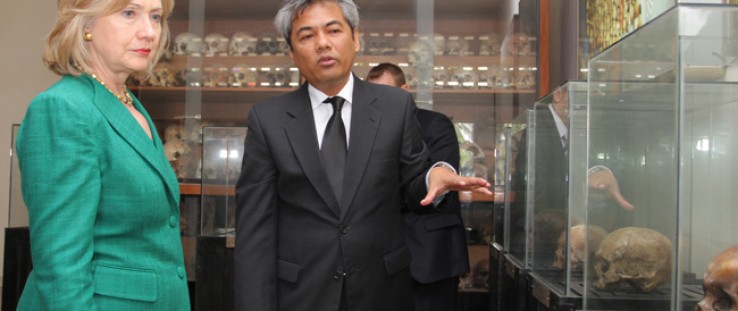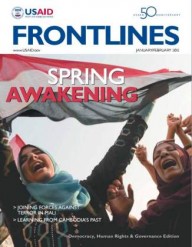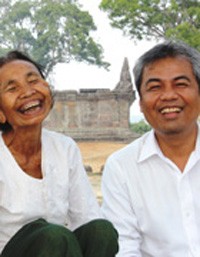 Secretary of State Hillary Rodham Clinton thanked Youk Chhang for a tour of the Tuol Sleng Museum. “Your telling of its history as well as the tragic accounts of the victims who suffered there were deeply moving,” she said.
U.S. Embassy Phnom Penh
Secretary of State Hillary Rodham Clinton thanked Youk Chhang for a tour of the Tuol Sleng Museum. “Your telling of its history as well as the tragic accounts of the victims who suffered there were deeply moving,” she said.
U.S. Embassy Phnom Penh
 Secretary of State Hillary Rodham Clinton thanked Youk Chhang for a tour of the Tuol Sleng Museum. “Your telling of its history as well as the tragic accounts of the victims who suffered there were deeply moving,” she said.
U.S. Embassy Phnom Penh
Secretary of State Hillary Rodham Clinton thanked Youk Chhang for a tour of the Tuol Sleng Museum. “Your telling of its history as well as the tragic accounts of the victims who suffered there were deeply moving,” she said.
U.S. Embassy Phnom Penh
Im Chaem, left, sits beside Youk Chhang, director of the Documentation Center of Cambodia, at Preah Vihear Temple on top of the Dangrek Mountain along the Cambodian-Thai border. Chaem, now 67, was a former chief of a district where many lives were lost to execution, starvation, and exhaustion during the regime of the Khmer Rouge.
Reflecting on the past isn’t always easy, but sometimes it is the only way to move forward. That is the belief of Youk Chhang, a survivor of Cambodia’s “killing fields,” who now directs the Documentation Center of Cambodia (DC-Cam), an independent Cambodian research institute in the country’s capital city dedicated to analyzing and preserving evidence of the past.
Millions of Cambodians were tortured and killed during the Khmer Rouge-led genocide from 1975 to 1979. The determination of the Khmer Rouge to completely remake Cambodia into a classless, agrarian society led to the slaughter of the educated and professional classes and the destruction of much of the nation’s infrastructure. The devastation of this period has hindered the pace and progress of development for more than 30 years and will affect the country for generations.
Spending his days surrounded by evidence of the Khmer Rouge’s horrific genocide, Chhang believes that the only way to heal—both personally and as a nation—is to document the past and learn from it.
“I am a survivor of Cambodia’s genocide,” he says. “All of us who lived through the genocide know that genocide devastates a country in many, many ways. And we need to make sense of our history before we can heal and move on.”
In the mid-1990s, Chhang, 50, received a U.S. grant to set up a field office in Phnom Penh to conduct research and gather documentation on the Khmer Rouge regime. In 1997, that field office became DC-Cam.
Over the past 14 years, DC-Cam has established the world’s largest archive on the Khmer Rouge period. It has catalogued approximately 155,000 pages of primary Khmer Rouge documents and more than 6,000 photographs of victims, perpetrators, and survivors. It has more than 800,000 additional pages of documentation and other types of materials that have not yet been catalogued. USAID has supported DC-Cam since 2004, and has since provided a $4 million endowment to help ensure its long-term sustainability. DC-Cam will use the earnings from the endowment to support ongoing activities and operate its permanent research and education center.
Related Content
“DC-Cam’s work helps rebuild Cambodian society by preserving the memory of the events of the past, and the effect on millions of Cambodians,” said USAID/Cambodia’s Director of the Office of Democracy and Governance Shally Prasad. “DC-Cam’s permanent research and education center will stand as a monument in their memory; encourage reflection, analysis, and discussion; and help build a national consciousness for healing and reconciliation. Thirty years after the end of the genocide, DC-Cam’s work is critical for moving the country forward.”
Documenting a Dark History
An official truth and reconciliation process has not yet occurred in Cambodia, but DC-Cam is using its in-depth archive to provide documentation to the ongoing Khmer Rouge trials, also known as the Extraordinary Chambers in the Courts of Cambodia (ECCC).
The ECCC is a special court established by the Cambodian Government and the United Nations to try senior members of the Khmer Rouge leadership for crimes against humanity. DC-Cam has already provided 500,000 pages of documents to the ECCC as well as photographs and video footage to the prosecution, defense, and civil party lawyers.
To date, the ECCC has convicted one person, Kaing Guek Eav, known as Duch, the former chief of S-21, a notorious Khmer Rouge prison. The trial of the second case involving four Khmer Rouge leaders has recently begun.
Judge Silvia Cartwright, formerly of the High Court in New Zealand before serving as an international judge at the ECCC, says: “The material provided by DC-Cam, that has been authenticated at trial, has been valuable in documenting the operations of the Democratic Kampuchea regime and has provided also some help to victims who have been searching for decades for information about their family members.”
Although the Khmer Rouge tribunal began 30 years after the end of the genocide, it represents an important step toward national reconciliation with the past.
“Never Again”
Youth age 30 or younger—who were not yet born at the time of the genocide—constitute 70 percent of Cambodia’s population of 14.5 million; therefore, DC-Cam also promotes genocide education for high school and university students, most of whom are the offspring of genocide victims or survivors.
As part of the national genocide education initiative, DC-Cam is conducting public awareness campaigns in rural towns and villages across the country. These campaigns help survivors—many of whom live with terrifying memories—bring closure to their past, as the country slowly rebuilds itself and national consciousness heals.
DC-Cam has succeeded in convincing the Ministry of Education to add a genocide studies component to the official high school curriculum. It provides specialized training to high school teachers to improve their understanding of the Khmer Rouge period and teach this sensitive and historical topic more effectively.
Officials say educating Cambodian youth about the Khmer Rouge ensures that the painful truth of the past is preserved, which helps to prevent similar tragedies. Their efforts are paying off.
One Cambodian 12th grader named Sothea said that, “previously when my parents told me about the Khmer Rouge era, I did not believe what they said …yet when … I have studied, I believe that those evil events did really happen.”
Another student, Sorya, struggles to make sense of the stories she has heard from relatives. She says: “I want to know why they (the Khmer Rouge) killed so many of their own people. I want to know why they left their own country in such terrible condition.”
Students study in the classroom and then speak with their parents and relatives at home about what they have learned. Educators say this intergenerational dialogue is important for understanding and healing.
Cambodia has changed a great deal since the Paris Peace Accords in 1991, which ushered in a period of renewal, reconstruction, and hope. Yet beneath the surface of Cambodia’s progress towards peace, reconciliation, and democracy lies the pain and trauma of the past. As Youk Chhang has said: “A society cannot know itself if it does not have an accurate memory of its own history.”
The Evolution of Cambodian Programs
USAID’s support for DC-Cam is part of the Agency’s broader efforts to help Cambodia come to terms with its past and achieve a brighter future. In the areas of democracy and governance, the Agency implements programs to strengthen human rights advocacy, the rule of law, youth leadership development, and elections and political processes.
The current USAID program in Cambodia traces its roots to humanitarian assistance activities in support of Cambodian non-communist resistance groups beginning in 1986. U.S. assistance to Cambodia accelerated sharply after the signing of the Paris Peace Accords in 1991, which in turn led to the re-opening of the USAID mission in 1992.
With the establishment of a full-scale mission, USAID shifted to a more strategic, long-term approach to reflect the development needs of Cambodia. While the initial focus was on meeting basic human needs, USAID also developed programs to support the U.N.-sponsored move to establish a freely elected government. Improved health and education services also emerged as key concerns.
USAID’s current program reaches all 24 provinces in Cambodia and has a 2010 fiscal year budget of $69 million.
“USAID programs in Cambodia have evolved over time, with U.S. Government policy and legislative parameters continuing to have an important impact,” said Mission Director Flynn Fuller. “In 2000, USAID was authorized to engage directly with the Government of Cambodia on issues related to HIV/AIDS. In 2002, this authority was extended to include programs related to basic education and trafficking. In 2007, Congress lifted restrictions barring most direct U.S. assistance to the Cambodian Government.
“Following this change, the United States now has bilateral agreements with Cambodia in health, education, and economic growth. A major focus of our development program—and I like to think we have been successful—is on supporting and strengthening civil society (local NGOs), including capacity building and their overall substantial contribution to the development of the country.”
From the outset, USAID funding was primarily delivered through contracts and grants to private voluntary organizations or international organizations, a pattern that continues to this day. To ensure sustainability, USAID increased the number of Cambodian-run organizations it has worked with over the years, with many going on to become some of the leading local NGOs in the country.
DC-Cam, just one of these successful Cambodian-run organizations, hopes to serve as a partner in global efforts against genocide by creating a permanent research and education center. In addition to continuing its present activities, it will add a museum, library, theater, and conference hall, and offer courses on genocide studies, human rights, and international law.










Comment
Make a general inquiry or suggest an improvement.